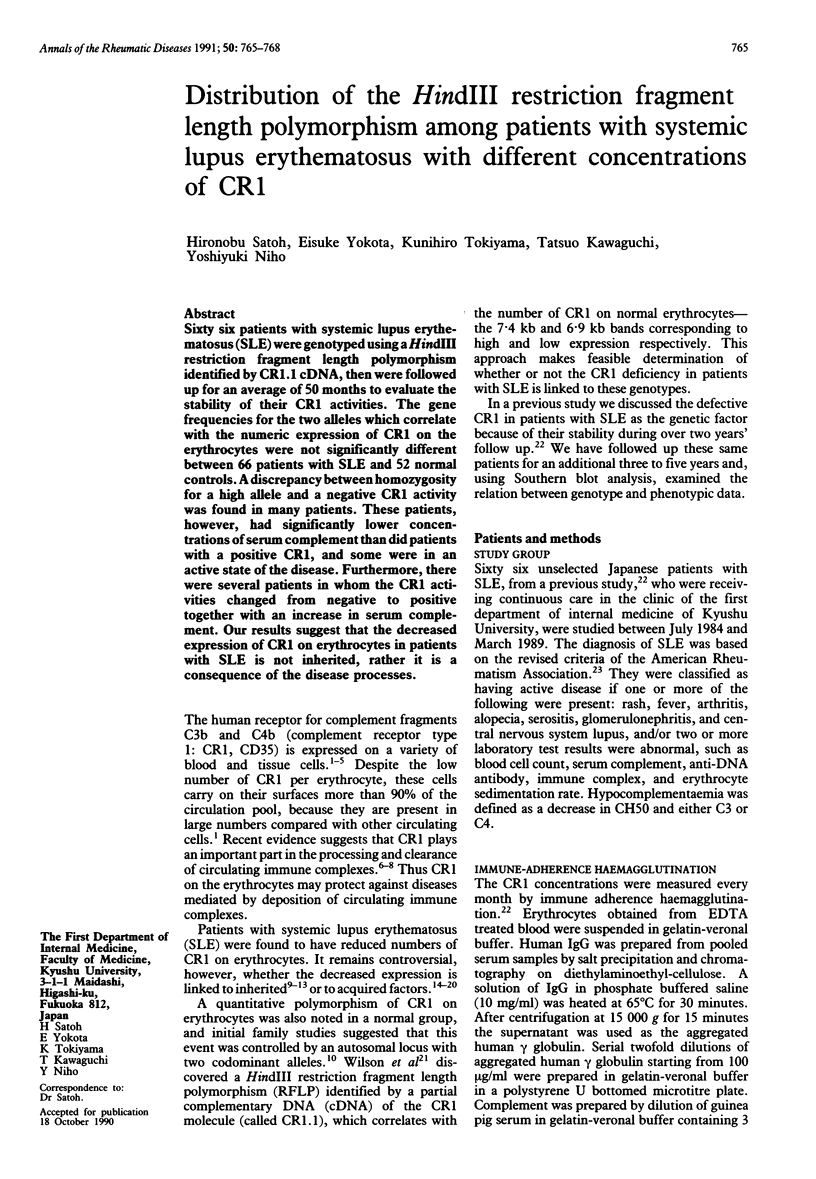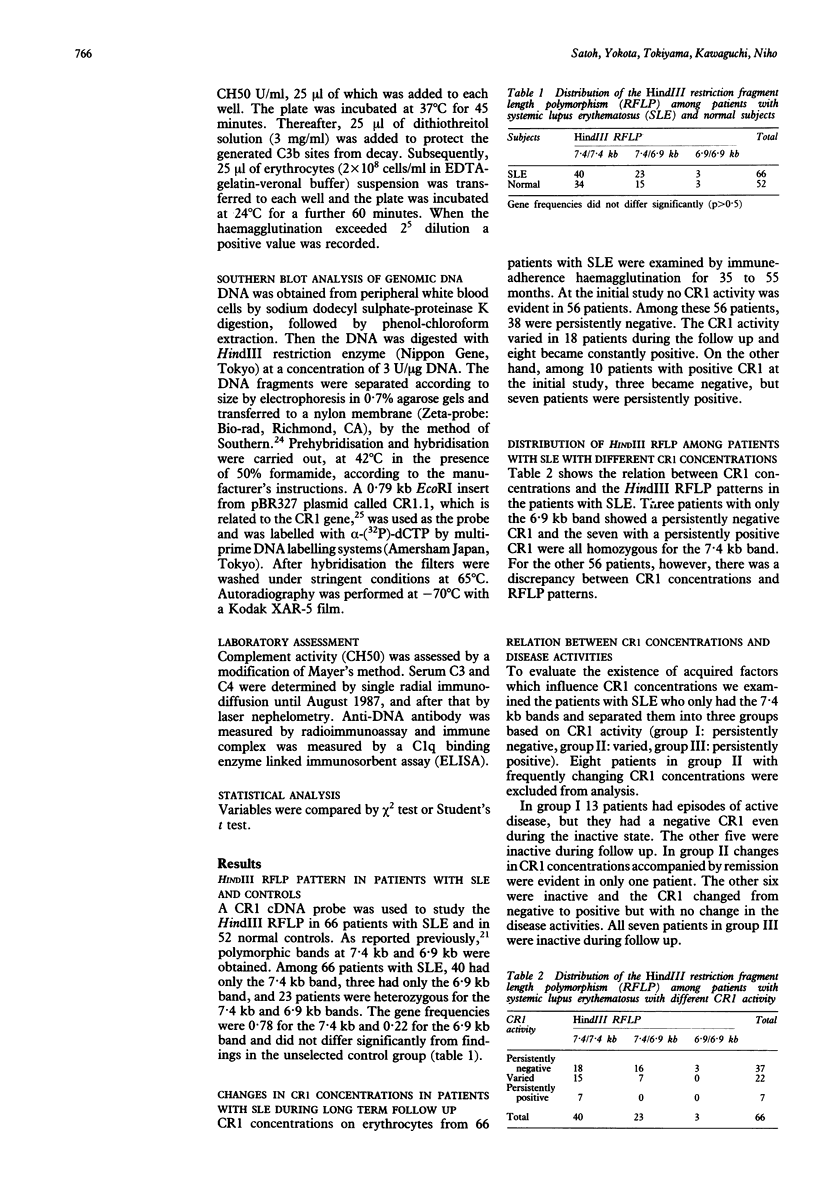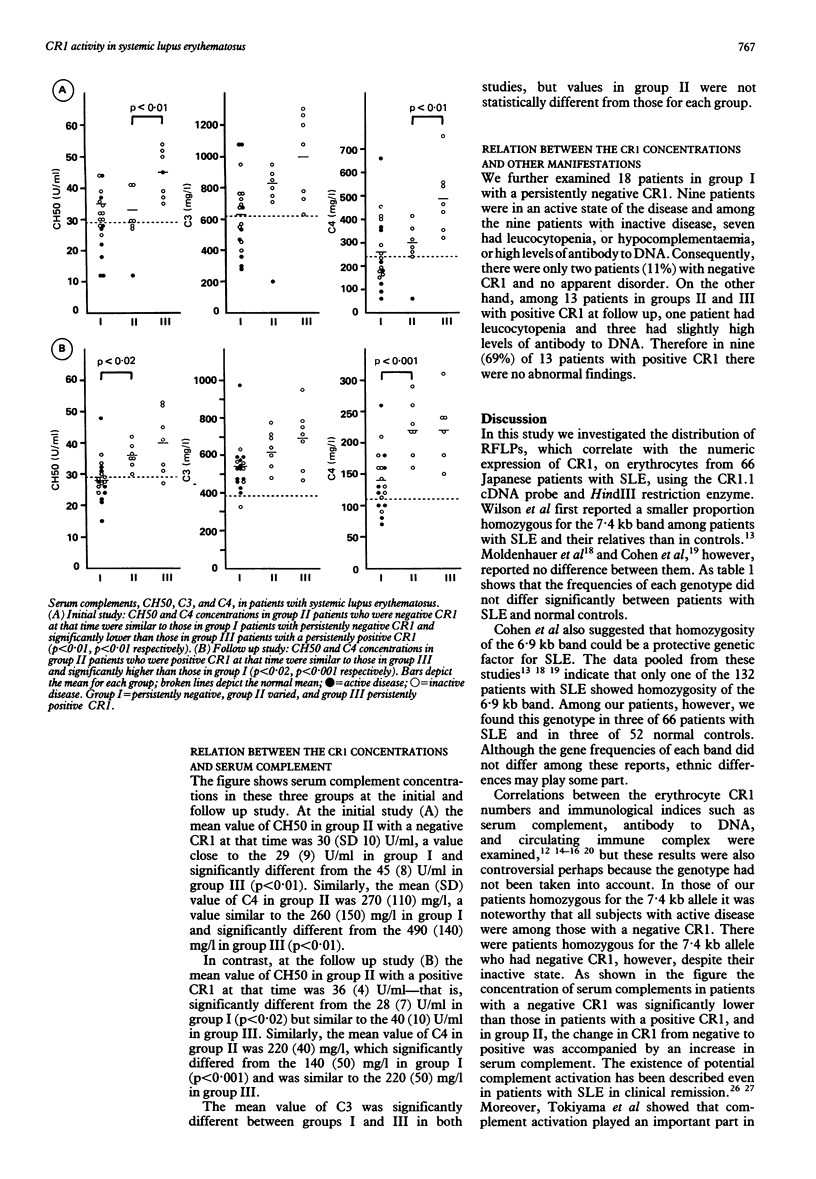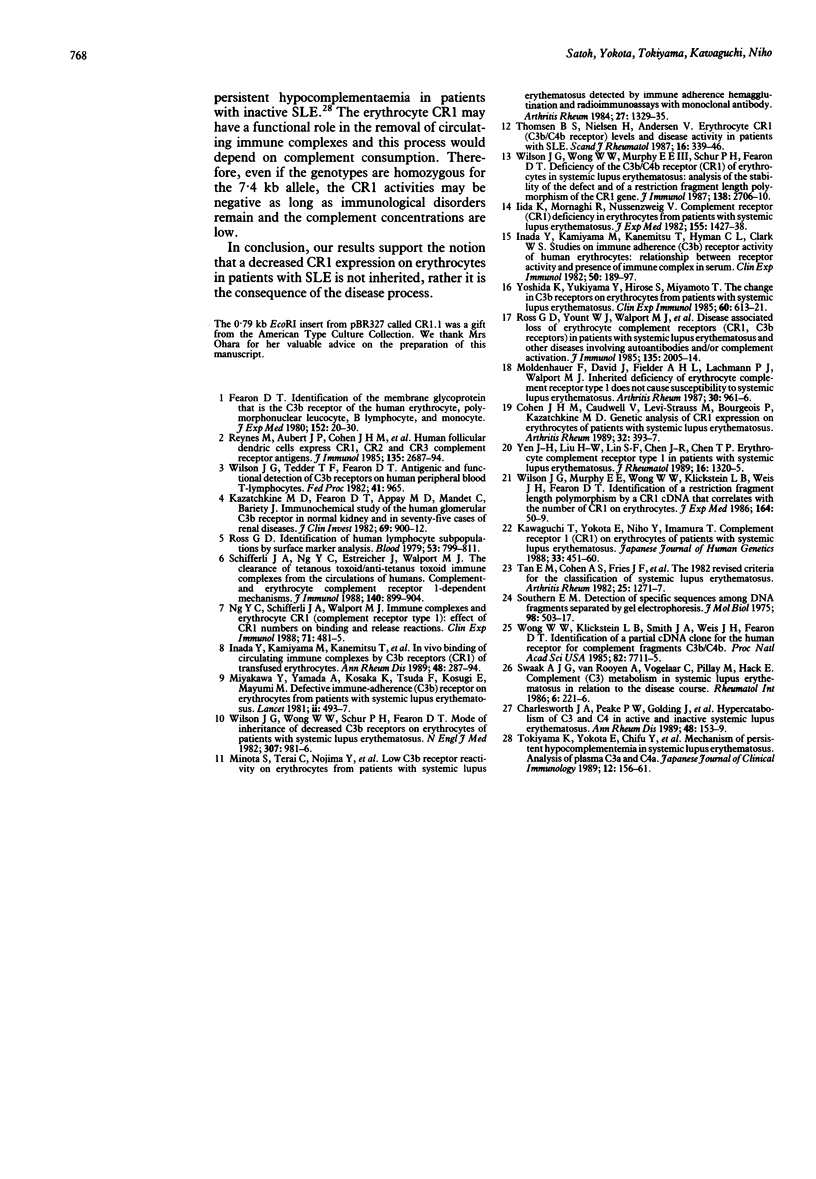Abstract
Sixty six patients with systemic lupus erythematosus (SLE) were genotyped using a HindIII restriction fragment length polymorphism identified by CR1.1 cDNA, then were followed up for an average of 50 months to evaluate the stability of their CR1 activities. The gene frequencies for the two alleles which correlate with the numeric expression of CR1 on the erythrocytes were not significantly different between 66 patients with SLE and 52 normal controls. A discrepancy between homozygosity for a high allele and a negative CR1 activity was found in many patients. These patients, however, had significantly lower concentrations of serum complement than did patients with a positive CR1, and some were in an active state of the disease. Furthermore, there were several patients in whom the CR1 activities changed from negative to positive together with an increase in serum complement. Our results suggest that the decreased expression of CR1 on erythrocytes in patients with SLE is not inherited, rather it is a consequence of the disease processes.
Full text
PDF



Selected References
These references are in PubMed. This may not be the complete list of references from this article.
- Charlesworth J. A., Peake P. W., Golding J., Mackie J. D., Pussell B. A., Timmermans V., Wakefield D. Hypercatabolism of C3 and C4 in active and inactive systemic lupus erythematosus. Ann Rheum Dis. 1989 Feb;48(2):153–159. doi: 10.1136/ard.48.2.153. [DOI] [PMC free article] [PubMed] [Google Scholar]
- Cohen J. H., Caudwell V., Levi-Strauss M., Bourgeois P., Kazatchkine M. D. Genetic analysis of CR1 expression on erythrocytes of patients with systemic lupus erythematosus. Arthritis Rheum. 1989 Apr;32(4):393–397. doi: 10.1002/anr.1780320407. [DOI] [PubMed] [Google Scholar]
- Fearon D. T. Identification of the membrane glycoprotein that is the C3b receptor of the human erythrocyte, polymorphonuclear leukocyte, B lymphocyte, and monocyte. J Exp Med. 1980 Jul 1;152(1):20–30. doi: 10.1084/jem.152.1.20. [DOI] [PMC free article] [PubMed] [Google Scholar]
- Iida K., Mornaghi R., Nussenzweig V. Complement receptor (CR1) deficiency in erythrocytes from patients with systemic lupus erythematosus. J Exp Med. 1982 May 1;155(5):1427–1438. doi: 10.1084/jem.155.5.1427. [DOI] [PMC free article] [PubMed] [Google Scholar]
- Inada Y., Kamiyama M., Kanemitsu T., Hyman C. L., Clark W. S. Studies on immune adherence (C3b) receptor activity of human erythrocytes: relationship between receptor activity and presence of immune complexes in serum. Clin Exp Immunol. 1982 Oct;50(1):189–197. [PMC free article] [PubMed] [Google Scholar]
- Inada Y., Kamiyama M., Kanemitsu T., Ikegami H., Watanabe K., Clark W. S., Asai Y. In vivo binding of circulating immune complexes by C3b receptors (CR1) of transfused erythrocytes. Ann Rheum Dis. 1989 Apr;48(4):287–294. doi: 10.1136/ard.48.4.287. [DOI] [PMC free article] [PubMed] [Google Scholar]
- Kazatchkine M. D., Fearon D. T., Appay M. D., Mandet C., Bariety J. Immunohistochemical study of the human glomerular C3b receptor in normal kidney and in seventy-five cases of renal diseases: loss of C3b receptor antigen in focal hyalinosis and in proliferative nephritis of systemic lupus erythematosus. J Clin Invest. 1982 Apr;69(4):900–912. doi: 10.1172/JCI110529. [DOI] [PMC free article] [PubMed] [Google Scholar]
- Minota S., Terai C., Nojima Y., Takano K., Takai E., Miyakawa Y., Takaku F. Low C3b receptor reactivity on erythrocytes from patients with systemic lupus erythematosus detected by immune adherence hemagglutination and radioimmunoassays with monoclonal antibody. Arthritis Rheum. 1984 Dec;27(12):1329–1335. doi: 10.1002/art.1780271202. [DOI] [PubMed] [Google Scholar]
- Miyakawa Y., Yamada A., Kosaka K., Tsuda F., Kosugi E., Mayumi M. Defective immune-adherence (C3b) receptor on erythrocytes from patients with systemic lupus erythematosus. Lancet. 1981 Sep 5;2(8245):493–497. doi: 10.1016/s0140-6736(81)90882-5. [DOI] [PubMed] [Google Scholar]
- Ng Y. C., Schifferli J. A., Walport M. J. Immune complexes and erythrocyte CR1 (complement receptor type 1): effect of CR1 numbers on binding and release reactions. Clin Exp Immunol. 1988 Mar;71(3):481–485. [PMC free article] [PubMed] [Google Scholar]
- Reynes M., Aubert J. P., Cohen J. H., Audouin J., Tricottet V., Diebold J., Kazatchkine M. D. Human follicular dendritic cells express CR1, CR2, and CR3 complement receptor antigens. J Immunol. 1985 Oct;135(4):2687–2694. [PubMed] [Google Scholar]
- Ross G. D. Identification of human lymphocyte subpopulations by surface marker analysis. Blood. 1979 May;53(5):799–811. [PubMed] [Google Scholar]
- Ross G. D., Yount W. J., Walport M. J., Winfield J. B., Parker C. J., Fuller C. R., Taylor R. P., Myones B. L., Lachmann P. J. Disease-associated loss of erythrocyte complement receptors (CR1, C3b receptors) in patients with systemic lupus erythematosus and other diseases involving autoantibodies and/or complement activation. J Immunol. 1985 Sep;135(3):2005–2014. [PubMed] [Google Scholar]
- Schifferli J. A., Ng Y. C., Estreicher J., Walport M. J. The clearance of tetanus toxoid/anti-tetanus toxoid immune complexes from the circulation of humans. Complement- and erythrocyte complement receptor 1-dependent mechanisms. J Immunol. 1988 Feb 1;140(3):899–904. [PubMed] [Google Scholar]
- Southern E. M. Detection of specific sequences among DNA fragments separated by gel electrophoresis. J Mol Biol. 1975 Nov 5;98(3):503–517. doi: 10.1016/s0022-2836(75)80083-0. [DOI] [PubMed] [Google Scholar]
- Swaak A. J., van Rooyen A., Vogelaar C., Pillay M., Hack E. Complement (C3) metabolism in systemic lupus erythematosus in relation to the disease course. Rheumatol Int. 1986;6(5):221–226. doi: 10.1007/BF00541371. [DOI] [PubMed] [Google Scholar]
- Tan E. M., Cohen A. S., Fries J. F., Masi A. T., McShane D. J., Rothfield N. F., Schaller J. G., Talal N., Winchester R. J. The 1982 revised criteria for the classification of systemic lupus erythematosus. Arthritis Rheum. 1982 Nov;25(11):1271–1277. doi: 10.1002/art.1780251101. [DOI] [PubMed] [Google Scholar]
- Thomsen B. S., Nielsen H., Andersen V. Erythrocyte CR1 (C3b/C4b receptor) levels and disease activity in patients with SLE. Scand J Rheumatol. 1987;16(5):339–346. doi: 10.3109/03009748709102505. [DOI] [PubMed] [Google Scholar]
- Wilson J. G., Wong W. W., Schur P. H., Fearon D. T. Mode of inheritance of decreased C3b receptors on erythrocytes of patients with systemic lupus erythematosus. N Engl J Med. 1982 Oct 14;307(16):981–986. doi: 10.1056/NEJM198210143071604. [DOI] [PubMed] [Google Scholar]
- Wong W. W., Klickstein L. B., Smith J. A., Weis J. H., Fearon D. T. Identification of a partial cDNA clone for the human receptor for complement fragments C3b/C4b. Proc Natl Acad Sci U S A. 1985 Nov;82(22):7711–7715. doi: 10.1073/pnas.82.22.7711. [DOI] [PMC free article] [PubMed] [Google Scholar]
- Yen J. H., Liu H. W., Lin S. F., Chen J. R., Chen T. P. Erythrocyte complement receptor type 1 in patients with systemic lupus erythematosus. J Rheumatol. 1989 Oct;16(10):1320–1325. [PubMed] [Google Scholar]
- Yoshida K., Yukiyama Y., Hirose S., Miyamoto T. The change in C3b receptors on erythrocytes from patients with systemic lupus erythematosus. Clin Exp Immunol. 1985 Jun;60(3):613–621. [PMC free article] [PubMed] [Google Scholar]


